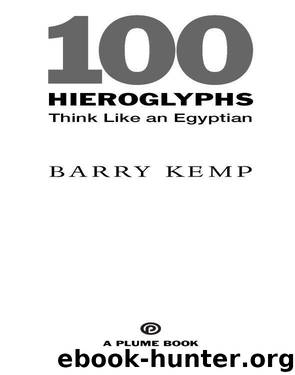Think Like an Egyptian by Barry Kemp

Author:Barry Kemp
Language: eng
Format: epub
Publisher: Penguin USA, Inc.
55.
CARTOUCHE
The hieroglyph shows a doubled loop of rope, the ends bound tightly around one part of the loop, then spreading out to form a straight line. It is a modification of a sign which shows a circle of rope with the ends unfixed that depicts the concept of a bounded space (thusn or shen) and is used as the determinative of the words “to encircle” and “circuit” (derived from the same root), referring to the whole world upon which the sun shone. An Egyptian king’s aspiration to rule the whole world was said to be over the “circuit of the sun-disc.” It became a symbol for “eternity” (the Shen symbol), presumably because the firmly bound loop contained no visible end.
The cartouche version of the sign appeared early in Egyptian history as a frame to pick out the name of the king, written inside the loop. The circular shape had to be elongated to accommodate the necessary line of hieroglyphs. The rope metaphorically contained and controlled the king’s territorial realm, perhaps in the way that the wooden beams of a ship were held in place by complex rope lashings (see no. 43, “Boat traveling upstream”).
At their coronation, Egyptian kings were given more than one name. By the beginning of the Middle Kingdom the full set numbered five. The first three, which did not use the cartouche, named the king as a manifestation of the god Horus and of the royal protective cobra and vulture goddesses, Wadjit and Nekhbet, who stood for Lower and Upper Egypt, respectively. “Horus” was the oldest name and had appeared by the time writing began in Egypt just before 3000 BC. A fourth name, written for the first time inside a cartouche, was added at the beginning of the Old Kingdom, and the fifth name, also in a cartouche, appeared intermittently in the later Old Kingdom before becoming obligatory.
The modern practice is to refer to kings by their fifth name (that is, the second of their cartouche names). This was frequently a pious statement about the gods: Amenemhat (“Amun at the forefront”), Djehutymes (or Tuthmosis, “Thoth has been born”), Amenhetep (“Amun is satisfied”). They sometimes became family traditions. The 12th Dynasty comprised three kings Senusret (“Man of the cobra-goddess”) and four kings Amenemhat. The 20th Dynasty produced an unbroken sequence of kings Rameses (“Ra has been born”), in the modern numbering sequence from III to XI. Later came royal families from outside, introducing kings with foreign names: the Libyans Osorkon and Takeloth, the Nubians Taharka and Shabaka, and the Persian Darijava(1)ush, whom the Greeks knew as Darius. Modern Egyptology has failed to find a consensus on spelling many of the kings” names, so that Djehutymes also appears as Thothmes or Tuthmosis, and Amenhetep as Amenophis.
Contemporary texts, however, more often referred to kings by their first cartouche name (the fourth of the full sequence of names). This was composed at the time of coronation, and for a long time was unique to an individual king. First cartouche names
Download
This site does not store any files on its server. We only index and link to content provided by other sites. Please contact the content providers to delete copyright contents if any and email us, we'll remove relevant links or contents immediately.
The Daily Stoic by Holiday Ryan & Hanselman Stephen(2703)
The Fate of Rome: Climate, Disease, and the End of an Empire (The Princeton History of the Ancient World) by Kyle Harper(2429)
People of the Earth: An Introduction to World Prehistory by Dr. Brian Fagan & Nadia Durrani(2345)
Ancient Worlds by Michael Scott(2098)
Babylon's Ark by Lawrence Anthony(2065)
Foreign Devils on the Silk Road: The Search for the Lost Treasures of Central Asia by Peter Hopkirk(2051)
India's Ancient Past by R.S. Sharma(1982)
MOSES THE EGYPTIAN by Jan Assmann(1968)
The Complete Dead Sea Scrolls in English (7th Edition) (Penguin Classics) by Geza Vermes(1835)
Lost Technologies of Ancient Egypt by Christopher Dunn(1796)
The Daily Stoic by Ryan Holiday & Stephen Hanselman(1764)
The Earth Chronicles Handbook by Zecharia Sitchin(1742)
24 Hours in Ancient Rome by Philip Matyszak(1675)
Alexander the Great by Philip Freeman(1642)
Aztec by Gary Jennings(1539)
The Nine Waves of Creation by Carl Johan Calleman(1518)
Curse Tablets and Binding Spells from the Ancient World by Gager John G.;(1509)
Before Atlantis by Frank Joseph(1481)
Earthmare: The Lost Book of Wars by Cergat(1465)
